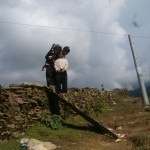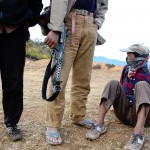
Original electric pole can be seen to the right. It now holds sophisticated wireless receivers and broadcasting equipment.
During the 1990s when teachers were being trained, higher level classes were added and income earning projects were started to support the new ventures Mahabir decided the school needed to be connected to the outside world. But first he needed electricity…a steady supply not dependent on Nepal Electricity Authority which ran one unreliable line into Nangi and practiced load shedding. With the help of another donation from his Kearney friends he purchased a water powered generator which was installed below the old Nangi Village on a hillside. The hydro power was able to generate one kilowatt of power, enough to run a few lights in the classrooms and ultimately the first two donated computers.
In 1997 the first two computers arrived in Nangi with Janita, a volunteer from Australia. She managed to take the large computers of the 1990s and tear them down into components small enough to arrive in benign looking boxes and tourist suitcases. Tourists’ personal items are rarely searched and over the years many more computers and components arrived this way until the computer revolution finally arrived in Nepal and parts became available. But it wasn’t until 2002 that the first wireless network was installed and Nangi connected to the world.

DAHABAN, WESTERN TERAI DISTRICT, NEPAL – FEBRUARY 15: Three PLA soldiers are returning to their batallion after a 10 day leave, February 15, 2005 in Nepal. They carry all their belonging in a back pack, and keep close their personal machine gun as close as possible. (Photo by Jonathan Alpeyrie/Getty images)
Nangi, Mahabir and the projects, like all of Nepal, limped along during the Nepalese Civil War (Maoist War) which raged from 1996 to 2006. During the early years of the war the conflicts were in the far east and west but gradually it encroached on the central Myagdi District. Mahabir insists the conflict did not stop his dream to connect the school to the world via the Internet because his activities were school related and had no political connections. Most of the Maoists were young teens and had no comprehension of the technology he was developing. Over the years of the war Mahabir kept a low profile and as we have come to understand…simply kept his head low and forged forward which is how he was able to build the first wireless network in Nepal in 2002.
Have you ever forged ahead with plans despite odds that seemed a sure bet for failure? Share your story with my readers. Join me next week for the start of chapter seven and the incredible tale of a wireless Internet in a village with no road, scant electricity and a mean annual income of $250 USD/year/family.
